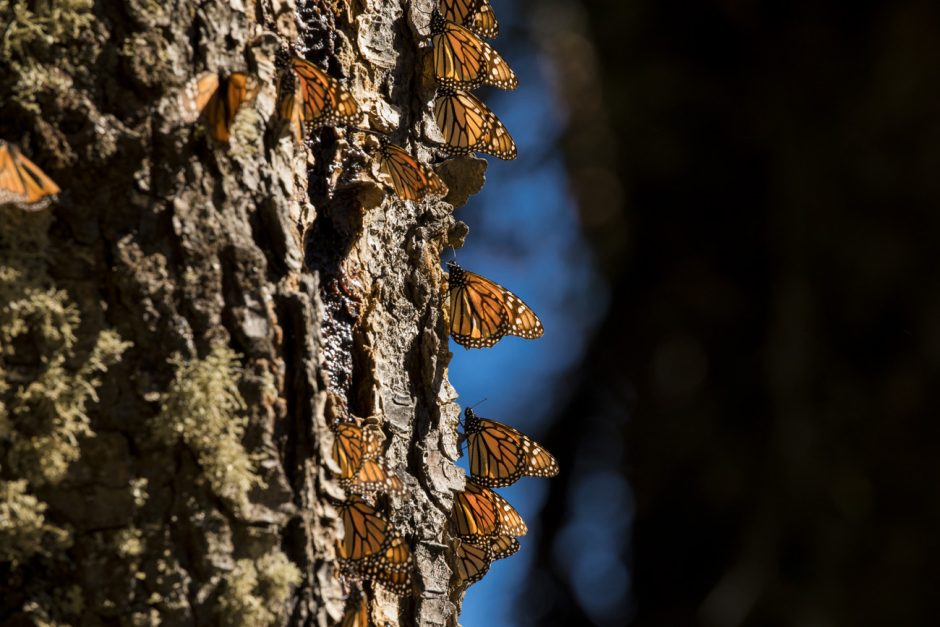
How to Get This Shot – Brilliant Butterflies in Mexico
Photographing the Monarch Butterfly Migration is one of the most spectacular and surprising things you can do in the world of nature and wildlife photography. It’s fascinating how many ways you can photography one species (albeit, several hundred million of that species) in their forest home in Mexico. However, there are certain challenges to capturing their brilliance. From photographing in their overwintering colonies for going on 17 years now, I’ve found that you must parse the various scenes before you into smaller components. One of such components you’re sure to see if you are on a monarch butterfly migration photo adventure is this wonderful “stain glass” look of perching butterflies on the sides of tree trunks.
There’s no doubt you’ll encounter a scene like this, so follow these tips on how to look for and ultimately capture this in its full glory. And if you want even more inspiration on what the monarch migration looks like, click on over to my article on 10 Inspirational Photos from the Monarch Butterfly Migration.
Finding the Shot
First, you’ll of course need to find the right shot. Getting to the overwintering colonies can be tricky if doing it on your own, hence I do strongly recommend going with an outfitter. I happen to be partial to Natural Habitat Adventures’ Monarch Migration Adventure. Having been guiding with them for many years I can say they are excellent at what they do. But as you can imagine, the colonies are quite diffuse, so you’ll still need to have your wits about you, and keep an eye out for things on the left and right of the trail, as photo opportunities indeed abound!
The thing you want to look for might seem easy, but just any old butterfly on the side of the tree isn’t exactly what we’re looking for. We’re looking for a handful of qualifiers. 1) We’re looking for several butterflies in the same area to then translate to the same frame in your shot. Not too tricky. 2) You need to find a tree that is somewhat close to the trail. Not tricky, but takes a little looking and an observant eye. 3) The butterflies should be positioned somewhat at eye level so that you get a good level shot. This gets trickier, as sometimes the butterflies can be higher in the trees, so it’s the exception and not the rule for them to be right at eye level.
How to Position Yourself
Once you find this particular scene, it’s time to position yourself. Generally you will be able to circle the tree somewhat…maybe not a full 360 degrees, but you can move yourself to get different backgrounds. This is exactly what we’re looking for–an interesting background. I’m personally partial to finding a good blue background from the sky, as it makes a lovely juxtaposition between the orange and black, with the rich blue so common in Mexico’s highlands. You COULD just take the first shot you see, as you walk up upon something like this, but it’s significantly more rewarding to really find that special lineup, with a good background.
Related to the background, the butterflies begin to really POP when you can get a little bit of light coming from behind them. I wouldn’t say backlit, as that’s a strong word, but as you can see from this photo, a little light coming through their wings makes things really interesting and really beautiful. With some luck and persistence, you can find that perfect scenario with blue background and a little light coming in at an angle. This is where the magic happens–this is photography.
Camera Settings
As far as settings, these are much more forgiving. It’s the rest of this list that’s the important part.
Nevertheless I’m partial to a relatively shallow depth of field, but somewhat in the middle. I’m thinking something like and f/5.6 or f/7.1. Not really shallow, but not really wide. Basically, what I’m trying to do is to get the butterflies and part of the trunk in excellent, sharp focus, but to blur out the background and perhaps part of the trunk, too. This is where you can experiment, and there is no magic number, as it’s quite dependent on how close you are to the trunk and butterflies. But what a great place to practice in! Try f/4 or even f/2.8 if you have the capabilities. Try f/8 or f/11 and see what happens. There is no perfectly right or wrong, and ultimately you have to be happy with the photo first and foremost, so experiment.
There are of course other things to consider, like composition specifically. However, I’m going to deliberately not concentrate on this, as it’s rather subjective in this case. It really depends on how the butterflies are arranged and where they are in relation to you. The main thing to consider is that you’re aiming to showcase the butterflies, of course, but you’re indirectly showcasing the scene and environment, too. You’re trying to bring in brilliant colors, and perhaps even the texture of the tree bark. It’s also helpful to take into account the overall pattern you’re showcasing. Thus, there are many things that could go into the equation of composition–it’s not quite as cut and dry as most “rule of thirds” style recommendations (although rule of the thirds is always a great place to begin).
I truly hope you’re able to go out and give this one a shot, as photographing the monarch butterflies in their overwintering home in Mexico is and always has been a highlight of my own photography career.
Cheers!

Court
Leave a reply